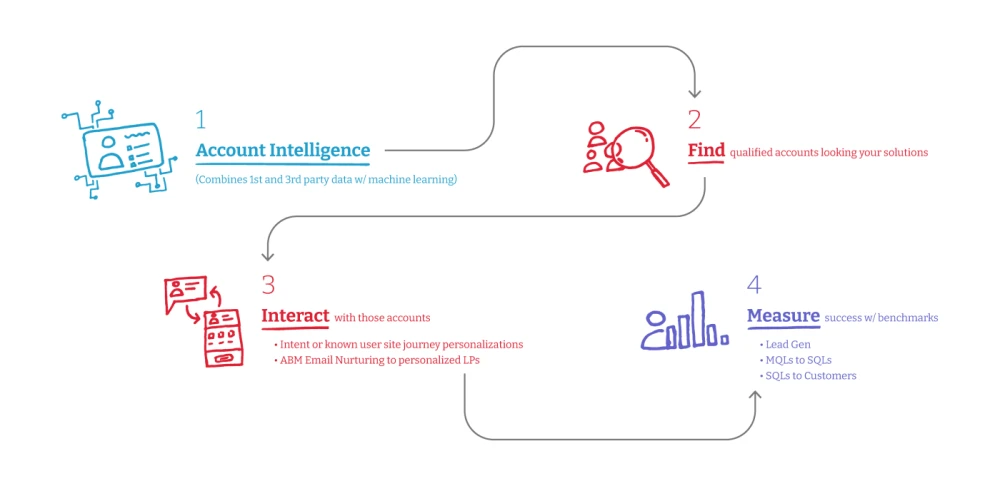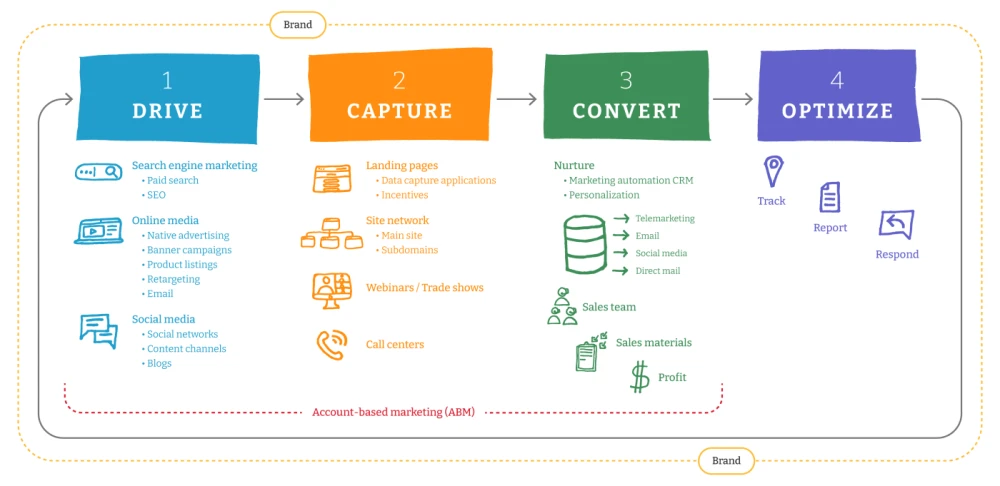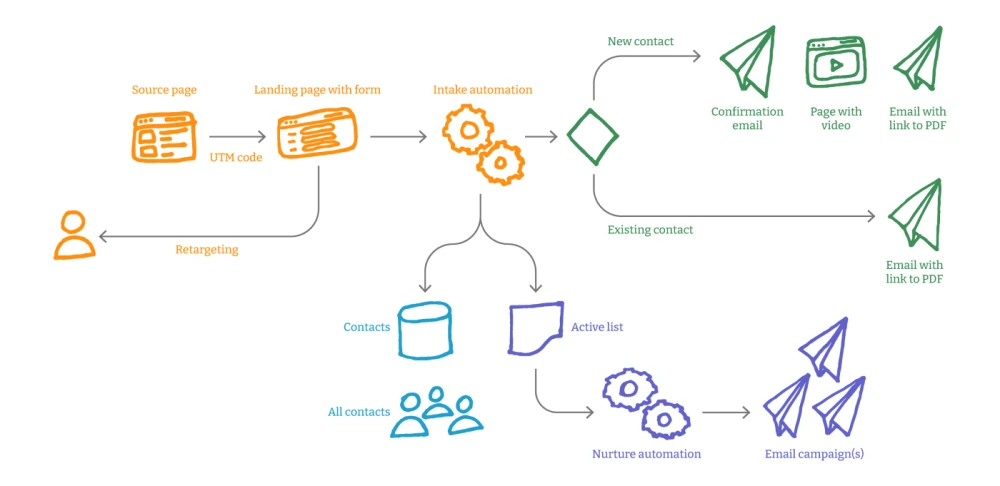Without the right strategy, tracking customer segments and how their journey brought them to you can be a treacherous mess. Observing your customers from start to sale through an end-to-end (E2E) marketing strategy can script this story for you, letting you know which campaigns and channels are the most successful. This isn't your grandfather's style of marketing strategy. An E2E strategy aims to develop a detailed image of what the customer wants by re-tracing their steps back to the beginning of their consumer decision-making. Read between the lines and you'll see what initiated your customers purchase(s).
Answered here:
What is end-to-end marketing?
End-to-end marketing (E2E) is a framework for your campaigns where all marketing interactions between customers and the business are viewed via a comprehensive set of moving parts, and each of these parts serves a particular function that informs the function that follows it.
In other words, this strategy follows the customer every step of the way. It allows marketers to analyze and build campaigns around the customer journey rather than depicting the customer base as a one-dimensional metric.
E2E gives marketers a breakdown of analytics that other strategies would otherwise only show you a broad overview of the lead conversion. It also allows you to plan for marketing among multiple channels in their campaigns.
Converting website visitors requires you to understand how they got there in the first place. Don’t simply watch the number of visitors on your site; look at the route they took via your marketing funnel.
Using customer journeys for end-to-end marketing
What is a customer journey?
Trace the digital footsteps of your customers A customer journey refers to the steps that a customer takes to purchase from a business. Customer journeys vary, so an end-to-end strategy depends on using these journeys to organize your marketing campaigns.
As marketers, it's important to understand how customers go from finding your business to purchasing from it. The basic stages of the customer journey are awareness, consideration, and purchase. Add a way to track the journey your customers take to the purchase stage and you’ll thank yourself later.
Stages of a customer journey
Awareness
In this stage, your potential customer searches for the solution to their problem and finds you through a medium of communication.
On your end, social media, paid media, conferences, your website, and other avenues to reach potential customers. Viewing sponsored advertisements or content from your company, and hearing about you through word-of-mouth are top ways that potential customers become aware of your brand and its products or services.
The better the messaging in these mediums, the more likely the consumer is going to consider what your brand provides as their projected solution. Use engagement data for analysis, such as impressions, clicks, sessions, and follows/likes to trace where the awareness of your brand began for certain folks.
Consideration
This stage is where the consumer weighs the different solutions they've been made aware of.
Your potential customer will need to learn from the information you provide about your business’s solution, so creating a stellar customer relationship through passive and active means is key.
Establish clear and obvious places on your website and social media channels where customers can reach a representative like a component for requesting information and pricing, such as a message box, email, or phone number.
Segment those considering your business and keep in contact with them; notify the potential customer of cart abandonment, target through email nurturing, and answer questions about the product or service they're interested in.
Decision
So they agreed to your solution in their first purchase at the decision stage, but that shouldn't be the end of the customer relationship. Track how the customer purchased from you, whether it's from the website or mobile app, over the phone, or in person. Keep up with the customers you've closed sales with and continue to target advertisements that are relevant to them and their familiarity with your brand.
Retaining customer loyalty is your next step, so strategizing with end-to-end marketing can help you reflect on the stages that led to the sale, and create better pathways for the customer to get to your solution.
Why should you use end-to-end marketing?
Four reasons, actually.
1. Account intelligence: Gather data and optimize campaigns.
2. Find qualified accounts: Identify quality leads.
3. Interact: Understand user journeys. Build Email nurturing campaigns and personalized landing pages
4. Measure your success: See lead generation. MQLs to SQLs. SQLs to customers.

Creating your E2E marketing plan
At Hounder, we've come up with our own step-by-step E2E marketing structure that we use in the B2B planning stages.

1. Drive
Create traffic to your website, social media accounts, and other channels of communication with your customers.
Search engine marketing
Paid search - Sponsor your website or a single blog post by paying a search engine to place your brand above the others. When someone searches and your topic, product, keyword, or service is relevant, yours will be the first result (with a "sponsored" or "ad" label next to it).
SEO - Learn how to drive traffic to your website with search engine optimization. You can organically rank higher on the search engine results page (SERP) with proper keywords, clear URL descriptions (something-like-this), and schema markup among other tricks. The goal is to nail that first page of Google; it shows visitors your reputability and relevance which is vital for their awareness and decision stages.
Online media
Native advertising - This is sponsored content you pay to implement into a publication's other articles. With due diligence, the content will be marked as sponsored, but your content will still take the form of its surrounding in-house media.
Banner campaigns - AKA banner advertisements or display ads, these are the digital billboards you see on a website. Drive traffic to your website with a visual and a quick, engaging phrase. Don't overload the banner with flashy glitter text akin to the early ages of the internet and gain more site visitors with clean, professional imagery.
Retargeting - Don't let them slip away. Reach out to previous visitors on your website or app with ads displaying their recently viewed items, or sending email reminders
Email marketing - Master the subject line; reel in potential leads by providing an email sign-up form but provide messages that won't end up in the customer's trash folder.
Social media
Social networks - Establish a social media presence for your brand and post frequent updates in the mediums, tone, and format that best fits your niche.
Content channels - Interlink your content across multiple channels. This cultivates a web of content all your business's own, where your customers and general visitors can stay within the bounds of your content curation.
Blogs - Create pieces of text-based evergreen content that will provide helpful information within your niche and leverage them to your products and/or services available. Use this for a call to action to generate sales or transmute your knowledge into thought leadership with the topics you have authority on.
2. Capture
Landing pages - These are standalone webpages that are driven from clicking a specific email link, advertisement, or other location. Determine the path your customer goes when they choose to see what you're offering. Bring them to a page tailored to the experience they are expecting and that will capture their attention the most.
Site network - Separate digital spaces within your website to make it clear to your visitors where everything is.
Webinars/Trade shows - Face-to-face interactions drive customer loyalty and buyer consideration. Post-pandemic, in-person business interactions are few and far between but serve as a great lead conversion opportunity. Your team members are there to explain to the consumers what you offer, their knowledge in a niche topic, and can answer to any roadblocks the person may have in their decision-making stage.
Call centers - When you have a company that begets a ton of phone calls, don't leave your leads left behind. Create a centralized or hire a remote call center to handle a large volume of potential buyers requesting information. Callers may be on the mend about your solution and need answers while considering, so don't lose the opportunity to convert them while they're available.
End-to-End flow and content mechanics:

3. Convert
Nurture
Applying marketing automation is integral for executing an E2E strategy. Tools like Hubspot and Sendinblue are examples of marketing automation that can keep your audience continuously in the loop. Customer Relationship Management (CRM) tools can help you track the communication with your customers and generate lead conversions.
Personalize all communications based on the current stage in their customer journey and by other means of segmentation. Personalization on your end equals resonation on the consumer's end; get them to acknowledge your brand first when they're in the consideration stage to convert them into your customer. Think about using a CDP or DXP to garner customer data segments that can help you tailor marketing campaigns.
Using email nurture campaigns can be finicky given how easy it is to throw marketing emails into the digital garbage if it seems irrelevant or boring enough. Think of the subject line as a push notification or a headline; this is the one piece of writing they must see before tossing it, so make it as catching as possible while offering useful information. This is the nudge you give your customers to repurchase and remind leads of your presence.
Don't rely on email marketing alone to nurture leads, couple it with direct mail and add a personalized approach to the mail you send out. Leads that sign up to be on your email list can easily block or unsubscribe for several reasons, usually when their inbox runneth over with ads. Consider a few messages to send out to those unsubscribed individuals to continue nurturing. Define what each of these should say based on their customer data, whether that's a birthday greeting or a reminder to renew a subscription to your service.
Show your customers that you're active in digital spaces they are by posting on social media. Responding to comments, messages, creating polls and interactive captions with relatable content are ways to nurture customer relationships and build engagement.
Whether its on the phone or over Zoom, telemarketing is still alive and well. Schedule a call with leads and previous customers to strengthen a connection with the individual or business. Especially in the B2B space, calls allow for subtle nurturing that feels more like a partnership than a business transaction.
Sales team
Sales materials
Profit
4. Optimize
Track
Watch your website analytics and customer data for new interests and lead conversions.
Report
Create comprehensive reports of your successes on your end-to-end marketing front.
Respond
Respond to customers and learn how to make your end-to-end journeys stronger.



